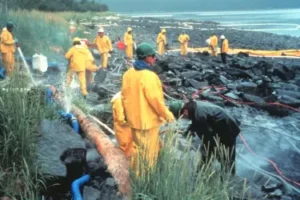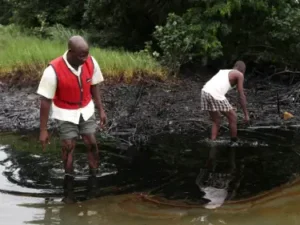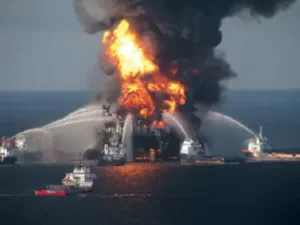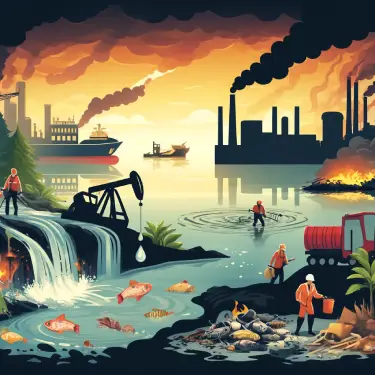Description: Corporate Environmental Breaches
Explore major corporate environmental breaches and abandoned mines, emphasizing accountability and justice.
SEO Introduction
Over the past fifty years, multinational corporations have been implicated in numerous environmental breaches, causing extensive damage to ecosystems and communities. Additionally, many corporations have abandoned mines without proper rehabilitation, leaving the environmental cleanup to governments and taxpayers.
This article provides an in-depth look at these issues, highlighting key incidents and the ongoing struggle for accountability and justice.
Problem: Major Environmental Breaches and Abandoned Mines
Environmental Disasters by Multinational Corporations
Rio Tinto – Panguna Copper Mine (1972-1989)
Location: Bougainville, Papua New Guinea
Details: The Panguna mine, ran by Rio Tinto, caused massive environmental destruction by dumping one billion tons of toxic mining waste into the local river system. This waste had sulphur, arsenic, copper, zinc, cadmium, and mercury, which made a forty-mile part of the river biologically dead.
The environmental degradation sparked a decade-long revolt by Bougainville residents and led to a lawsuit against Rio Tinto in U.S. federal court. Despite the mine’s closure, its legacy of pollution and social unrest remains. Source: https://www.cfr.org/timeline/ecological-disasters.
Union Carbide – Bhopal Disaster (1984)
Location: Bhopal, India
Details: The Bhopal disaster is one of the world’s worst industrial accidents. A gas leak from Union Carbide’s pesticide plant released methyl isocyanate, killing thousands, and affecting over half a million people with chronic health issues, including respiratory problems and birth defects.
The Indian government accepted a settlement of $470 million from Union Carbide, but victims argue that the compensation was inadequate. Efforts to hold the company accountable continue to this day. Source: https://www.cfr.org/timeline/ecological-disasters.
Exxon Valdez Oil Spill (1989)

Location: Prince William Sound, Alaska, USA
Details: The Exxon Valdez oil tanker spilled millions of gallons of crude oil, causing extensive damage to marine life and the local environment (Council on Foreign Relations). The cleanup and litigation costs were large, with Exxon facing significant fines.
The spill led to changes in U.S. regulations about oil transportation and spill prevention, yet the environmental impact persists, with lingering oil residues still affecting the ecosystem. Source: https://www.cfr.org/timeline/ecological-disasters.
Vedanta Resources – Zambia (2019)
Location: Zambia
Details: Vedanta Resources was found liable by the UK Supreme Court for environmental damage caused by its subsidiary, Konkola Copper Mines (KCM), in Zambia (Cambridge University Press & Assessment).
The court ruled that Vedanta exercised significant control over KCM’s operations, thereby setting up a duty of care. This landmark case underscores the importance of holding parent companies accountable for the actions of their subsidiaries abroad. Source: Cambridge University Press & Assessment.
Shell – Nigeria (1990s-Present)

Location: Niger Delta, Nigeria
Details: Shell has been implicated in numerous oil spills in the Niger Delta, causing severe environmental damage and affecting local communities. The spills have devastated ecosystems, polluted water sources, and led to health issues among residents.
Legal battles continue as affected communities seek compensation and cleanup efforts. The Nigerian government and international bodies have criticized Shell for its inadequate response to the environmental crises it has caused.
Shell’s complicity extends to human rights abuses, including the murder of villagers and the execution of environmental activist Ken Saro-Wiwa and eight others in 1995.Source: https://thelawyer.africa/2021/12/01/the-role-of-mncs-in-environmental-damage-in-africa/ and Source:https://thelawyer.africa/2021/12/01/international-frameworks-on-mncs-and-environment/.
Deepwater Horizon Oil Spill (2010)

The Deepwater Horizon oil rig explosion in the Gulf of Mexico, operated by BP, resulted in one of the largest marine oil spills in history. The disaster killed eleven workers and released millions of barrels of oil, causing extensive damage to marine and coastal ecosystems, and affecting local industries: Source: https://www.cfr.org/timeline/ecological-disasters and source: https://thelawyer.africa/2021/12/01/international-frameworks-on-mncs-and-environment/.
Abandoned Mines Not Rehabilitated
South Africa
South Africa faces significant challenges with thousands of abandoned mines, including coal mines. A 2022 report highlighted that only twenty-seven out of 2,322 high-risk mines were rehabilitated between 2009 and 2021.
The lack of enforcement and proper financial provisions has left many communities exposed to hazardous conditions. Toxic water from these mines has contaminated local water supplies, posing severe health risks to residents. Source: https://www.hrw.org/report/2022/07/05/forever-mines/perpetual-rights-risks-unrehabilitated-coal-mines-south-africa and source: https://www.hrw.org/news/2022/07/05/interview-how-south-africas-abandoned-mines-prey-local-communities.
Australia
Australia has an estimated 60,000 abandoned mine sites, many left without proper rehabilitation. The mining boom has left a legacy of environmental degradation, with regulatory and financial constraints hindering cleanup efforts.
The diverse ecosystems affected by these mines face significant restoration challenges, and the financial burden often falls on the government due to insufficient provisions set aside by mining companies. Source: https://ensia.com/features/australia-mine-rehabilitation/.
Canada
Canada has around 10,000 orphaned or abandoned mines. Efforts to improve legislative and policy frameworks for rehabilitation have been made, but many sites still are unaddressed. The National Orphaned/Abandoned Mines Advisory Committee works to enhance cooperation among stakeholders, but the scale of the issue requires substantial resources and long-term commitment: Source: https://ensia.com/features/australia-mine-rehabilitation/.
The Impact of Environmental Breaches and Abandoned Mines
The environmental and social impacts of these incidents are profound and far-reaching. Toxic waste and oil spills have devastated ecosystems, polluted water sources, and caused serious health issues among affected communities. Abandoned mines pose ongoing risks, including water contamination, soil erosion, and hazards to residents.
Emotional and Social Repercussions
– Health Impacts: Chronic health conditions, birth defects, and respiratory issues plague communities affected by environmental disasters.
– Economic Consequences: Local industries, such as fishing and agriculture, suffer due to polluted environments, leading to economic instability.
– Human Rights Violations: The complicity of corporations in human rights abuses, such as the execution of activists, highlights the grave social injustices tied to environmental exploitation.
Case Study: The Ogoni Nine

The execution of Ken Saro-Wiwa and eight other Ogoni activists by the Nigerian military government, allegedly in collaboration with Shell, underscores the intersection of environmental exploitation and human rights abuses. This tragic event highlights the dire need for corporate accountability and justice for affected communities. Source: https://thelawyer.africa/2021/12/01/the-role-of-mncs-in-environmental-damage-in-africa/ and source: https://thelawyer.africa/2021/12/01/international-frameworks-on-mncs-and-environment/.
Strengthening Regulations and Accountability
Comprehensive Solutions for Environmental Justice
Enforcing Stricter Regulations
Governments and international bodies must enforce stricter environmental standards and ensure corporations adhere to them. This includes:
– Mandatory Rehabilitation Plans: Corporations should have to submit and follow through on detailed mine rehabilitation plans.
– Financial Provisions: Adequate financial reserves must be set aside by corporations to cover the costs of environmental cleanup.
Enhancing Monitoring and Enforcement
– Regular Inspections: Increased frequency and thoroughness of environmental inspections to ensure compliance with regulations.
– Penalties for Non-Compliance: Imposing significant fines and legal penalties on corporations that do not meet environmental standards.
Supporting Affected Communities
– Compensation and Rehabilitation: Providing adequate compensation and support for communities affected by environmental disasters.
– Health Services: Setting up health services and programs to address the medical needs of affected populations.
Tools and Insights for Advocacy
Legal Frameworks and Advocacy
– International Treaties: Strengthening international treaties and agreements to hold corporations accountable for environmental damage.
– Legal Recourse: Supporting legal actions against corporations to secure justice and compensation for affected communities.
Community Engagement and Awareness
– Public Awareness Campaigns: Raising awareness about environmental breaches and abandoned mines through media and community outreach.
– Grassroots Movements: Empowering local communities to advocate for their rights and hold corporations accountable.
Summary
The environmental breaches and abandoned mines left by multinational corporations over the past fifty years highlight the urgent need for stronger regulations and accountability measures. These incidents have caused severe ecological damage and health issues, with affected communities often enduring most of the consequences. Governments and international bodies must enforce stricter environmental standards and ensure that corporations are held responsible for their actions.
Question for Readers
What measures do you think should be implemented to ensure proper rehabilitation of abandoned mines by multinational corporations?
Call to Action
Support policies and organizations that advocate for corporate accountability and environmental justice. Raise awareness about these issues and push for stronger enforcement of rehabilitation requirements to protect our planet and communities. Share this article widely on social media to spread awareness and drive change.
By understanding the history and effects of these corporate actions, we can work towards a more sustainable and just future. Support the movement for environmental justice by sharing this article and taking action in your community.
References
“Timeline: Major Environmental Disasters,” Council on Foreign Relations. Link: Council on Foreign Relations.
“Transnational Corporate Liability for Environmental Damage and Climate Change: Reassessing Access to Justice after Vedanta v. Lungowe,” Cambridge Core. link: Cambridge University Press & Assessment.
“The Role of Multi-National Corporations (MNCs) in Environmental Damage in Africa,” The Lawyer Africa. Link: The Lawyer Africa.
“The Forever Mines: Perpetual Rights Risks from Unrehabilitated Coal Mines in South Africa,” Human Rights Watch. Link: Human Rights Watch.
“Can Australia rehabilitate its thousands of legacy mine sites?” Link: Ensia.

